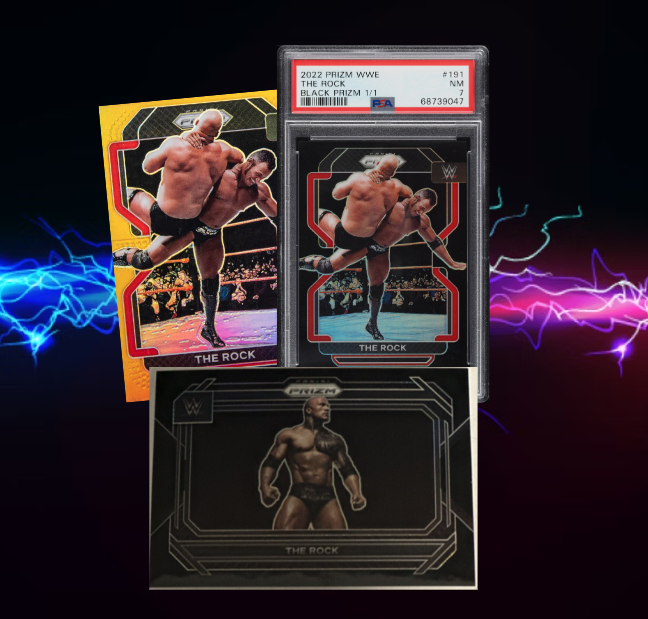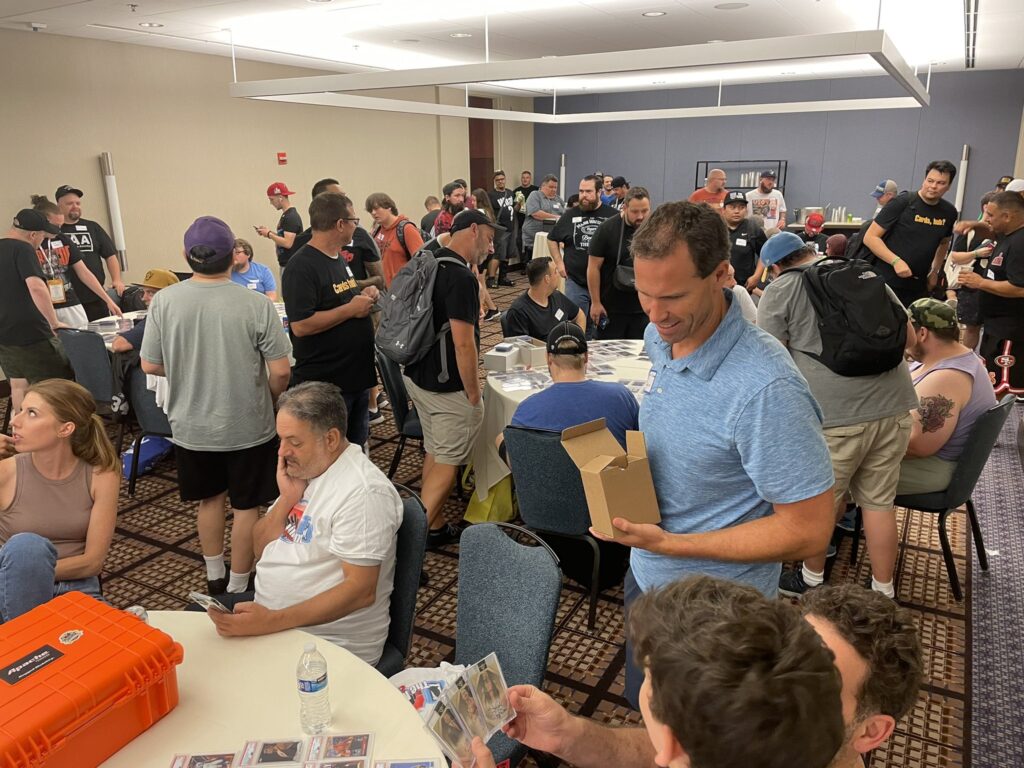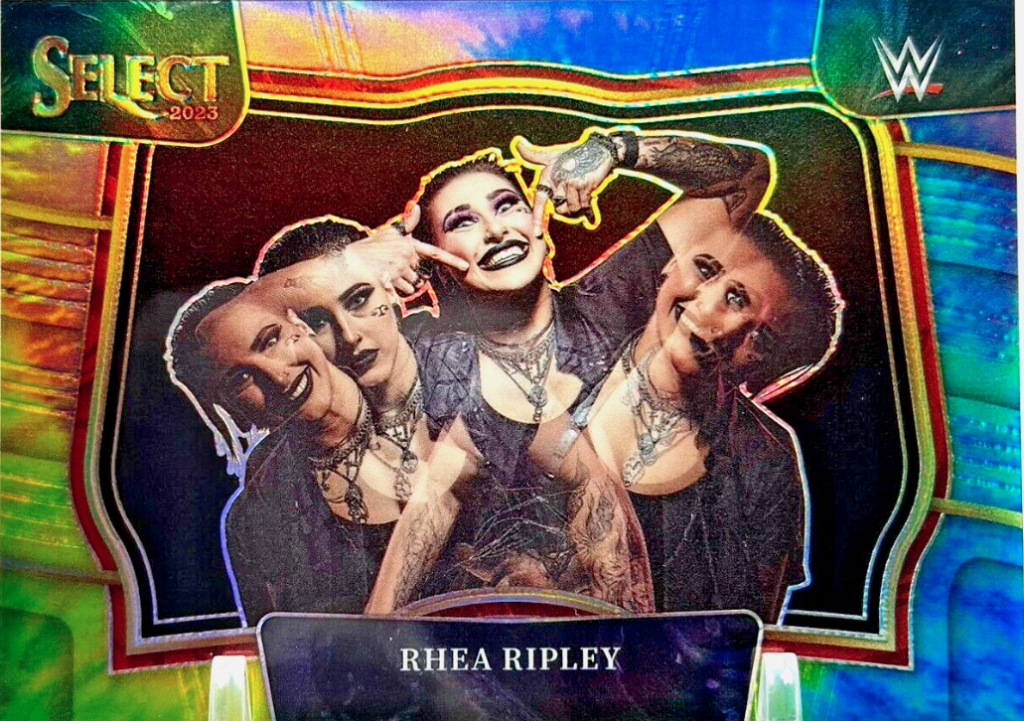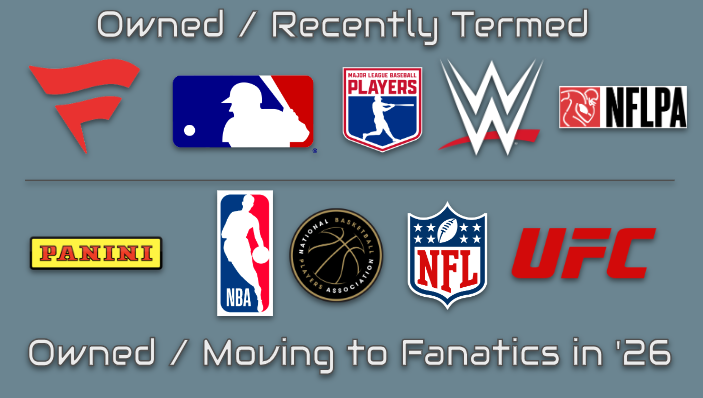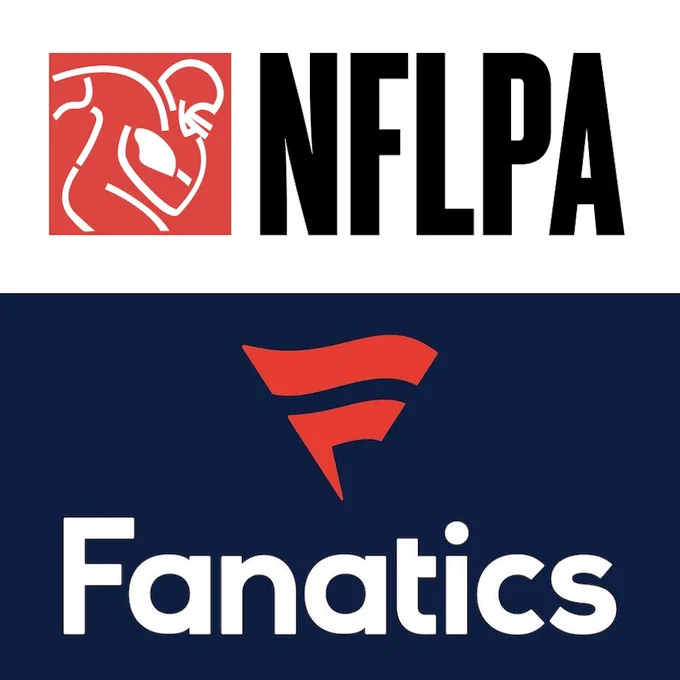Although it could be a long drawn out process, the Panini era in wrestling cards looks to be in a state of flux. WWE has effectively terminated their relationship in favor of moving forward early with Fanatics, a move that was already in place to happen in 2026. With Topps under the Fanatics banner of hobby consolidation, many in the hobby are left wondering what brand name will be on the cards they are buying in the future. Will it be the originator of the modern wrestling card era with Topps, or the company responsible for the boom after Topps lost the license in Panini?
More importantly, if this is the end of Panini WWE, what can we take away from this 18 month period in the timeline of the hobby? I wanted to look back as a sort of retrospective, but also talk about the impact of Panini’s legacy in WWE even after Topps returns.
Part 1 – Panini Accelerated The Boom of WWE cards
When I started collecting WWE in 2017, it was easy to find wrestling cards in the budget area of a local card shop. Ebay listings were a small trickle of new cards, rather than the deluge we see today. Wax prices were beyond affordable, where many of the products could be bought by the case for the same price as a single box of cards in other sports.
When the Pandemic forced everyone to change their daily lives, and cards became the new hot collectible item, Wrestling cards lagged behind. Most prices in 2020 stayed pretty static, while the rest of the hobby exploded. While Topps was closing out their first run in WWE, Panini established themselves as the premier sports card brand, as Prizm, National Treasures and Contenders started churning out five figure sales every day of every week for multiple years.
Eventually, in mid 2021, Panini announced publicly that they had acquired the license to produce WWE cards. For the first time in the modern era, all the standards that funded the recent boom would make their way to wrestling. Because of the way Panini branded cards had performed in the years leading up to the boom, as well as during the boom, almost instantly WWE was on the radar for investors and thousands of new collector eyes.
Modern Topps WWE cards shot up in value almost overnight, with shiny sets like Chrome, Finest and others quadrupling in value. We also saw the first five figure modern wrestling card sale, and content flowing from podcasts, youtubers, and collectors on a new WWE hobby stage.
Although wrestling cards had started to trend upwards by the time the announcement was made, the acceleration of that growth after the Panini announcement was undeniable. Panini had started a fire, and the smoke around the future of WWE in the hobby was starting to get awfully thick. That wouldnt have happened in such an accelerated fashion without Panini in the mix. Love them or hate them for what they stand for in other sports, coming to wrestling brought a ton of attention and value to this niche area.
Part 2 – Panini Produced the Most Valuable Wrestling Card(s) of All Time
Ill get to the community divide here in a minute, but there is no amount of screaming or yelling that can offset the numbers Panini put on the board during this 18 month period. When Prizm was released in April of 2022, there were multiple gigantic sales of cards that created all new records for the history books. Prizm black 1/1s of big names started cranking out five figure sales beyond a number of expectations, and the Rock’s Prizm gold sold for absolute mega money to the point where it started challenging all time numbers.
The one card people were looking for took a while to surface, and when it did, the mainstream hobby took notice. The Rock’s Prizm Black 1/1 was pulled in a break and sold twice privately before ending up with prominent IG account “Thatstheoldprice.” His affinity for big time Prizm black cards is known hobby wide, thanks to his acquisition of gigantic cards of Patrick Mahomes, Tom Brady, and Lebron James. Adding the Rock to his collection set an all time sales record, but because the sale was private, many questioned it’s true number. When it was eventually listed for sale on PWCC’s elite auction over the spring of 2023, it was time to see the true power of the Panini brand.
Although the auction started slowly, the final price was something that no one expected. Selling for a massive $126k closing price, the Panini modern era of WWE cards had produced a unicorn sale. Not only did it more than double the price of the previous record wrestling card sale, it was a stake in the ground for what Panini was capable of in a smaller market area for the hobby.
Other huge sales followed, including another 5 figure sale of the Rock’s black prizm from the sophomore Prizm set. Panini brand power was on display during these last two years, and its a major component of the legacy they will leave behind. Its possible that Topps comes back and creates new standards, but the consistent value of the top end of Panini’s values look to be untouchable.
Part 3 – Panini Split the Once Harmonious Community
One of the main reasons that I loved wrestling cards more than any other type of card is because of the people. I loved how the community banded together for each other, helping collectors connect with each other, and cheering each other on as they achieved milestones in their PCs. It was truly a situation that should have been a model for the rest of the hobby, and it was the one thing that wrestling cards had above every other niche. It was one of the main reasons we were able to have so much success in creating the Main Event for the 2023 National Convention.
When Panini came to town, everything seemed to change. The community became split over the new era, mainly the pre-conceived understandings of rising prices and exposure to parts of the hobby landscape that wrestling was previously immune to. A portion of the community longed for the chance to collect their favorite Panini brands for the first time in WWE, regardless of the price. The other side of the community felt like everything would change for the negative, given Panini’s history of issues in NFL and NBA.
Wrestling card social media became a very contentious place for collectors to engage, especially as Panini collectors and previous community members clashed over the impact the new cards were having on the market. Many felt they would be priced out, or unable to continue the way they had before, angry and bitter that higher prices and more eyes on wrestling cards had changed their ability to exist the same way in the hobby.
As for the people joining up, they were exposed to both sides of the aisle very quickly. A celebration of the new life that wrestling cards had taken on, combined with gatekeeping and vitriol from others. Some of the anger stemmed from a lack of understanding of the greater hobby and how Panini had created such an immense following, as many existing wrestling collectors werent familiar with the ways of the greater hobby and the way collectors assigned value to cards and parallels.
In similar fashion, the newer collectors coming in were subject to some culture shock a bit, as the Wrestling Card community was tight knit, and very particular in the way they approached their collections. Lack of understanding of why people werent wise to the modern hobby norms, or just general personality differences led to blowups all over facebook, twitter and other platforms.
Part 4 – Panini Showed What Was Possible in Modern WWE Cards
For years, Topps had a method of operations in their product releases. A focused checklist of current stars and legends that signed for each product, coupled with relic content that focused on pieces of mat provided by WWE from their events. Up until 2018, Topps did have access to things like shirts and other relics, but over time, they stopped using them in product as the supply seemed to run out and not be replaced.
When Panini came in, they turned everything on its ear. Huge signer checklists with readily available autograph content of seemingly every star on the roster, and all the top legends of the attitude era that Topps reserved for big product releases to drive value. Giant names like Stone Cold Steve Austin, Undertaker, Hulk Hogan and John Cena became available in every product, giving collectors access to autograph content that was out of reach during most of Topps’ run from 2013 on. Panini also dove deep into the annals of WWE lore, getting people to sign for sets that had rarely signed, or never signed. ECW, WWF, and even some of the older territory wrestlers became common checklist subjects, much to the joy of collectors who grew up during the respective eras.
Panini also opened up the doors on player worn relics, which brought a ton of variety and fun to products over their run. Instead of relying solely on match used materials, Panini and WWE coordinated to have superstars wear shirts and other items during signings to then cut up and include as swatch content in most of the releases.
For the first time ever, there were chases in WWE sets that mirrored the favorites in the mainstream four sports. WWE logos, patches, and relic content that used the extensive library of colorful shirts available on WWEshop became a standard, and with new content, brought huge value in the box hits for premium sets like Immaculate and Impeccable.
In Immaculate, the new relic content was coupled with on card signatures that was never achieved in the Topps era outside of some rare examples. Multi-signed on card autographs were also available for the product as well, something Topps only achieved in very specific circumstances in Transcendent. Stars like Roman Reigns, Becky Lynch, Rhea Ripley and others were paired with quad signed and triple signed cards across a product that might have been the most extensive wrestling product ever created.
Topps will have their work cut out for them to equal the level of content that Panini, but hopefully this approach will be possible across Topps legacy brands like Transcendent, Chrome, Finest and potential new brands like Dynasty. Because Panini was spending 3-4x in licensing costs with their time, versus what Topps was originally spending, there is a lot of hope within the community that having a larger budget could open up avenues unavailable previously. Topps has their own hobby standards that were similarly successful over the boom period, and now that they have this roadmap of possibilities, we might see how those standards are applied to wrestling cards in a similar fashion to Panini.
Part 5 – Panini Had Issues With Timing Across the Board
When looking back over the last year plus, it was clear that Panini did a lot of things that were great. They continually fell short in one area, and that is timing. Products releasing on time, autograph redemptions being fulfilled for certain superstars, and things like the Asia configurations being basically non-existent until a year after their release.
In terms of releases, Products rarely hit their timelines, which is beyond problematic. It was a horrific issue for Topps as well, but given the circumstances, it doesnt change how frustrating it is to have consistent delays across the board. There were multiple products that released weeks to months after they were supposed to hit shelves, and I can only imagine what it must be like for the breakers who have to pay for allocations and then not get them on time.
Similarly, many products, especially Immaculate, had redemption issues for top guys. Its one thing if the redemption is for Ivar or Chad Gable, but Roman Reigns, Hulk Hogan and the Undertaker were all late in getting their cards back. I want these people in the products, and I understand the logistical issues that align with hard signed cards. However, it doesnt make it less of a problem. Thankfully most of the redemptions are at a better spot now, but some remain woefully on the indefinite calendar of waiting.
Part 6 – Panini’s Photos in Every Product Might Be the Best in the History of Trading Cards
Yes, this is a very hot take, but Ive been collecting cards for a long time, and I have never been so impressed with photos the way that they were used in every Panini WWE product. There are very few instances where a photo sank a Panini WWE card, but very many instances where a photo choice made a Panini WWE card more valuable.
Panini’s focus on moments that made fans excited for the product on television made perfect sense, especially in cards that define Panini WWE as a whole. Topps was notorious for snoozeworthy photo choices or relying on renders supplied by WWE to make their products. Panini had a wonderful balance of epic moments, championship moments, and history in all their products, and it made every single set stand out among the crowd.
With Select, the photos became the selling point as much as the cards themselves, with almost universal praise for how much better the cards looked as a result of how the photos were chosen. Adding in a wide ranging checklist of current stars and legends, and it became abundantly clear the amount of care that went into choosing the photo for each subject.
There have been awesome photo focused sets in other sports too, Stadium Club Baseball comes to mind. The consistency of greatness across every Panini WWE product is unparalleled.
Part 7 – Product Quality Was Up and Down for the Biggest Sets of the Year
I remember seeing the first packs of Prizm WWE opened, and I couldnt help but notice all the issues that were in place for centering and surface of the cards. I hadnt opened a Panini product in a long time, and I hadnt had the experience of how Panini QC could impact a product.
Prizm seemed to be the tip of the iceberg, and even worse, it seemed to get worse year over year. In 2022 Prizm, the vertically oriented base cards and the white sparkle parallel packs were filled with centering issues. In Select and Impeccable, there were major issues with collation, and how the cards were put into the packs themselves.
Although design, photos and autograph content were all top notch, the way those cards were put into practice had a very up and down life at Panini. This is pretty consistent over the entirety of their business, and its unfortunate they couldnt get past it in WWE circles.
Part 8 – Panini Found Ways to Make People Aware of What They Were Doing in WWE
From the time that Prizm was announced, to their recent booth setup at the NSCC, Panini made WWE a focus for their entire brand across the hobby. They found ways to incorporate their WWE license into new spaces that Topps was never able to do, and as a result, many more people saw that wrestling cards were a viable focus for a trading card or memorabilia collection.
I remember when I first saw Panini WWE cards being advertised during the live broadcast of WWE RAW and Smackdown and how cool that was. I may not have the clearest memory, but I dont remember the last time cards got a spotlight on any sort of WWE programming.
Additionally, there was a gigantic WWE wall on their booth for the national convention, cards in the giveaway packs delivered for wrapper redemptions, and wrestling cards in the VIP packs for the party that is held annually.
Panini also got WWE superstars to make videos ripping packs, which were then showcased all over social media. These types of activities are all exceptionally helpful in driving new attention for the wrestling card market.
Overall, there were some major issues that happened during the last few years, but I cant help but talk about how shocked I am at the success that Panini has had. I went into this era with VERY low expectations given my experiences in the other sports. Panini found a niche to do some great things in a small market, which has created undeniable buzz and entertainment for collectors. That is a legacy that hopefully stands the test of time.

